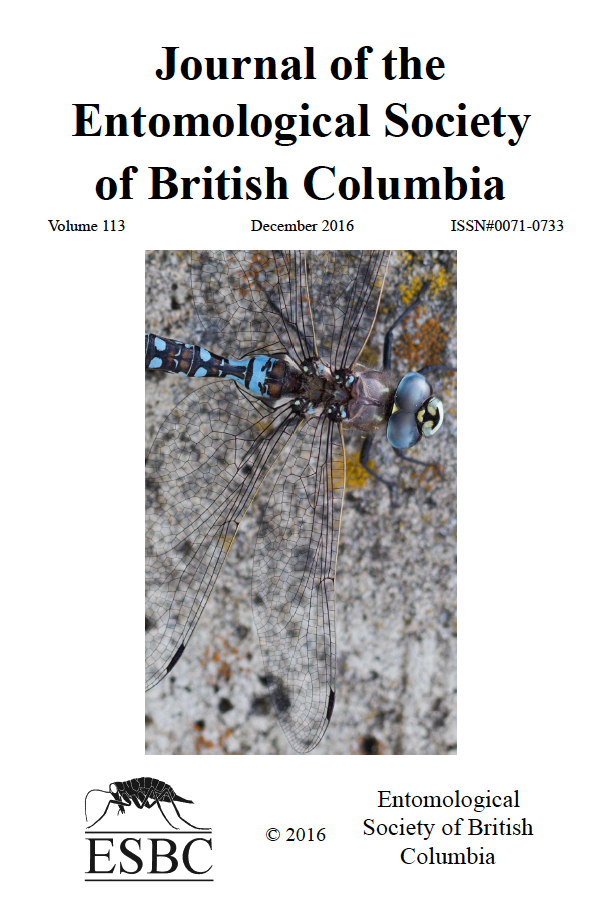Pollination Science and Stewardship Symposium
Keywords:
Apoidea, Diptera, Lepidoptera, Pollination, PollinatorAbstract
Pollination is a vital ecological process in terrestrial ecosystems. Pollinators are the organisms that provide this service, thus facilitating reproductive success in plant communities. Awareness of the importance of pollinators and pollination has increased in the last few decades, largely due to global declines in honey bee colonies and documented widespread declines of some bumble bee and other pollinator species. In Canada, the main pollinators are the insects, with 1000s of species from a wide range of taxa that regularly visit flowers. Among the most familiar and important insect pollinators are the butterflies and moths (Lepidoptera), many groups of flies (Diptera) and beetles (Coleoptera), and the Hymenoptera, which includes the bees and many other types of wasps. On March 17, 2016 a symposium titled “Pollination Science and Stewardship” was held at Okanagan College Campus in Penticton, British Columbia. The symposium brought together twelve presenters to speak about current research and topics on the diversity, conservation, ecosystem services, pesticide management, agriculture, citizen science and stewardship for pollinators, with focus on Canada. The workshop also aimed to facilitate connections between pollination specialists and lands managers, owners, stewards and biologists, thus enabling information and idea exchange such that these practitioners could then apply it to their own conservation work. The symposium attendance was in excess of 90 people. A broad range of interested participants came to the event; members of academia and professionals from industry, agriculturalists, citizen scientists, artists, students, gardeners and landowners interested in enhancing their properties for pollinators. The symposium was supported by funding from Environment Canada Habitat Stewardship Program for Species At Risk, British Columbia Ministry of Environment, the Royal Saskatchewan Museum and the Entomological Society of British Columbia.
References
Adderley L, Vamosi J. 2015. Species and phylogenetic heterogeneity in pollinator visitation affects selfing and seed production in an island system. International Journal of Plant Sciences 176: 186-196.
Bruckman D, Campbell DR. 2014. Floral neighborhood influences pollinator assemblages and effective pollination in a native plant. Oecologia 176(2): 465-476.
Da Silva EM, King VM, Russell-Mercier JL, Sargent R. 2013 Evidence for pollen limitation of a native plant in invaded communities. Oecologia 172: 469-476.
Davila Y, Elle E, Vamosi J, Hermanutz L, Kerr J, Lortie C, Westwood A, Woodcock T, Worley A. 2012. Ecosystem services of pollinator diversity: a review of the relationship with pollen limitation of plant reproduction. Botany 90: 535-543.
Ingram M, Buchmann S, Nabhan G 2002. Our forgotten pollinators: Protecting the birds and the bees. In: Kimbrell A ed. The Fatal Harvest Reader: The tragedy of industrial agriculture. Washington, D.C.: Island Press, 191-207.
Kerr JT, Pindar A, Galpern P, Packer L, Potts SG, Roberts SM, Rasmont P, Schweiger O, Colla SR, Richardson LL, et al. 2015. Climate change impacts on bumblebees converge across continents. Science 349(6244): 177-180.
Knight TM, Steets JA, Vamosi JC, Mazer SJ, Burd M, Campbell DR, Dudash MR, Johnston MO, Mitchell RJ, Ashman T-L. 2005. Pollen limitation of plant reproduction: pattern and process. Ann. Rev. Ecol. Evol. Syst. 36: 467-497.
Potts SG, Biesmeijer JC, Kremen C, Neumann P, Schweiger O, Kunin WE. 2010. Global pollinator declines: trends, impacts and drivers. Trends in Ecology & Evolution 25(6): 345-353.
Vamosi J, Knight T, Steets J, Mazer S, Burd M, Ashman T-L. 2006. Pollination decays in biodiversity hotspots. Proc. Nat. Acad. Sci. USA 103: 956-961.
Vamosi J.C., Moray C, N Garcha N, SA Chamberlain S, Mooers A. 2014. Pollinators visit related plant species across 29 plant-pollinator networks. Ecology and Evolution 4: 2303-2315.
Villalobos S, Vamosi JC. 2016. Increasing land use drives changes in plant phylogenetic diversity and prevalence of specialists. PeerJ 4: e1740 https://doi.org/1710.7717/peerj.1740.
Downloads
Published
Issue
Section
License
Authors who publish with the Journal of the Entomological Society of British Columbia agree to the following terms:
-Authors retain copyright and grant the journal right of first publication with the work simultaneously licensed under a Creative Commons Attribution License that allows others to share the work with an acknowledgement of the work's authorship and initial publication in this journal.
-Authors are able to enter into separate, additional contractual arrangements for the non-exclusive distribution of the journal's published version of the work (e.g., post it to an institutional repository or publish it in a book), with an acknowledgement of its initial publication in this journal.
-Authors are permitted and encouraged to post their work online (e.g., in institutional repositories or on their website) prior to and during the submission process, as it can lead to productive exchanges, as well as earlier and greater citation of published work (See The Effect of Open Access).


